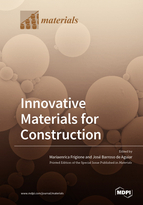Innovative Materials for Construction
A special issue of Materials (ISSN 1996-1944). This special issue belongs to the section "Construction and Building Materials".
Deadline for manuscript submissions: closed (15 September 2020) | Viewed by 42034
Special Issue Editors
Interests: cold-cured adhesives and matrices for FRP employed in constructions; polymeric nanostructured adhesives and coatings; hydrophobic coatings for stone conservation and wood protection; durability of polymers, adhesives and coatings; eco-efficient materials for construction and cultural heritage
Special Issues, Collections and Topics in MDPI journals
Interests: sustainable construction; energy efficiency of buildings; phase change materials; composite materials; material durability; construction and demolition wastes; foundry industry wastes; polymers in concrete
Special Issues, Collections and Topics in MDPI journals
Special Issue Information
Dear Colleagues,
Most of the typical materials employed in today’s construction industry present limitations, especially with regard to their durability—in either common or severe environmental conditions—and their impact on the environment. In response to these issues, academic and industrial efforts around the world have been devoted to developing new smart materials that can provide efficient alternatives, improve energy efficiency in buildings, or upgrade, repair, and protect existing infrastructures. Different and wide technological innovations are, therefore, quickly fostering advancements in the field of construction materials. A new generation of materials (e.g., bricks, cement, coatings, concrete, FRP, glass, masonry, mortars, nanomaterials, PCM, polymers, steel, wood, etc.) is, in fact, gaining a prominent position in modern building technology, because such materials are able to overcome various limitations and flaws of the conventional materials employed in construction, without neglecting the smart applications of pioneering materials in ancient constructions and historic buildings.
Even though the adoption of innovative materials in the field of construction has been demonstrated to be a successful strategy to achieve enhanced performance or even new and unexpected characteristics, several issues are still not completely resolved. On top of those issues, the cost/performance ratio of the novel solutions is important, because such materials must be demonstrated to be convenient without compromising quality. Other concerns are related to their sustainability: whether they are eco-friendly options, exploiting recycled materials or byproducts from other productions—the most desirable solution. Finally, the use of materials or systems that are unconventional in this field creates the need to update or develop new specifications and standards.
This Special Issue aims to provide a platform for discussing open issues, challenges, and achievements related to innovative materials proposed for use in the construction industry.
Prof. Mariaenrica Frigione
Prof. José Barroso de Aguiar
Guest Editors
Manuscript Submission Information
Manuscripts should be submitted online at www.mdpi.com by registering and logging in to this website. Once you are registered, click here to go to the submission form. Manuscripts can be submitted until the deadline. All submissions that pass pre-check are peer-reviewed. Accepted papers will be published continuously in the journal (as soon as accepted) and will be listed together on the special issue website. Research articles, review articles as well as short communications are invited. For planned papers, a title and short abstract (about 100 words) can be sent to the Editorial Office for announcement on this website.
Submitted manuscripts should not have been published previously, nor be under consideration for publication elsewhere (except conference proceedings papers). All manuscripts are thoroughly refereed through a single-blind peer-review process. A guide for authors and other relevant information for submission of manuscripts is available on the Instructions for Authors page. Materials is an international peer-reviewed open access semimonthly journal published by MDPI.
Please visit the Instructions for Authors page before submitting a manuscript. The Article Processing Charge (APC) for publication in this open access journal is 2600 CHF (Swiss Francs). Submitted papers should be well formatted and use good English. Authors may use MDPI's English editing service prior to publication or during author revisions.
Keywords
- Auto-repairing features
- Durability
- Energy-efficiency
- Increase in human comfort
- Nanotechnology
- New standards
- Recycling
- Reduction of natural resources
- Renewability
- Self-cleaning characteristics
- Sustainability








